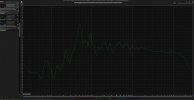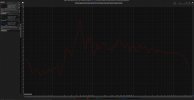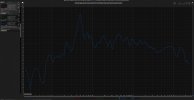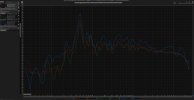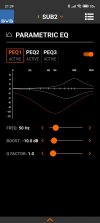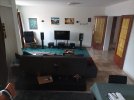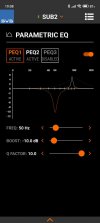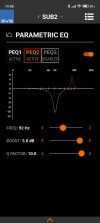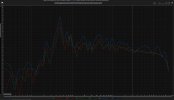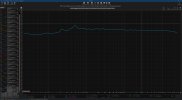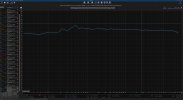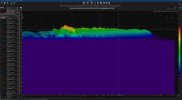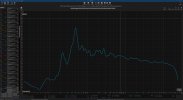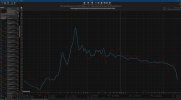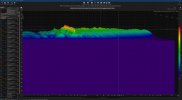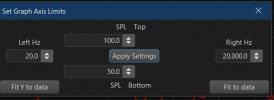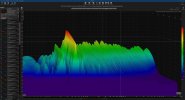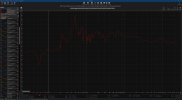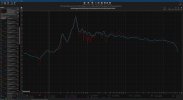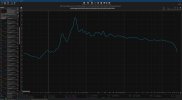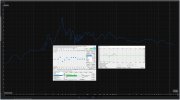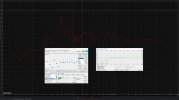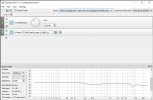This is indeed what I did.
I applied these PEQ settings on both of my subs via the SVS app and repeated the same exact measurements so to find out if they make any difference.
But as you say there is no difference with my previous measurements.
So this leads me to think that or I am doing something wrong or that the PEQ SVS feature will not work in my room/case and I shall not loose more time with it.
I agree that the measurements show that your DSP is not applying your PEQ. I don't know why, might be a software setting.
I get what you say about ETC and spectrogram but the problem is I will not be able to interpret this data.
And this is what happens with REW each time I try to dive into it.
The guides, posts, suggestions are unlimited and, if you don't have some background or knowledge of sound science, you find yourself lost in the options and ending up in a discouraging constant doubt about your choices.
That is what ASR is for, we are here to help. Feel free to post whatever graphs and .MDAT's you have trouble interpreting. Subwoofer integration is not easy, there are multiple threads on ASR of people struggling with their subs.
In plus, for the majority of guides the existence of devices like minidsp or streamers with dirac modules and similar is a prerequisite. While I don't have one in my chain(topping e30>topping pre90>arthur 3409/N2 power amp) and this makes it even more complicated.
Can I add a minidsp in my current chain? What will be the benefits?
What could be my other options given above limitations?
Of course you can add a MiniDSP to your current chain. Broadly speaking, you have two options when it comes to DSP: hardware based, or software based. Hardware based (e.g. MiniDSP, DEQX) have the advantage in that they are one box integrated solutions with software included. They have other niceties like built-in DAC's with the correct connectors, remote control, and a large user base with their own support forum. However, I do not like the MiniDSP and these reasons may not apply to you. It is limited in processing power, and it uses mixed phase filters. Mixed phase has some advantages, it is less computationally intensive and it has low latency. However, it can not correct bass to any high degree of resolution.
The ultimate solution would be a software solution similar to what
@OCA recommended - i.e. use your computer to perform DSP. However, going down this route is more complex and has a steep learning curve. To see what you are in for, take a look at
OCA's Youtube channel and see if you can understand what he says in his videos. I have an above average understanding of DSP, and I still struggle to understand half the things he says. You can take your pick from free software (REW/RePhase) to paid (Acourate, Audiolense, Dirac, Focus Fidelity). These software packages differ in how much control they allow you to have, and ease of use for beginners. In general, software which gives you more control, i.e. forces you to look at graphs and make your own decisions, is better and more powerful. Examples are REW and Acourate. I do not suggest beginners take this route, unless you are exceptionally persistent and prepared to make DSP your new hobby. You are better off going with something like Audiolense or Focus Fidelity which have more automation and is easier for beginners.
For software based correction, you will need: (1) a PC, (2) an interface card with as many DAC channels as you need like the
RME Babyface (4 channels) or the
Motu Ultralite Mk5 (8 channels), (3) 48V phantom power microphone and stand, (4) the software.
The advantage of going down either route is much better integration of your sub with your mains. Subs need to be adjusted in amplitude, phase, and time to match your mains. It is simply not possible to do this with any precision without DSP. I believe that anybody who owns a sub needs DSP, otherwise they are not getting the most from their sub. But that's just my opinion.
I hate this door(s) more than you.
I even completely removed it when I firstly placed my speakers on their current position, but it had to be put back as I faced a house revolution minutes after the removal.
It has these terrible glass fully resonating tiles. Which are hold in place by a metal frame. In a door with 54 years on its back.
I can remember them rattling with smaller, but differently placed, speakers. They do not give an identifiable vibration or sound with my current setup though. But they are still a very negative influence in a room that, while non treated, is furnished with 'sound friendly' objects.
I will inspect more closely as you suggest.
Really thank you for the rubber gaskets suggestion. I think I will add them in both doors.
It's not only the doors that can rattle in the jambs, the glass panes can rattle as well. If it's the glass panes you might need silicone sealant. Run a bead of sealant between the glass and the frame. It took me months to fix the issues in my listening room - windows, doors, furniture, picture frames, light fittings, you name it. I played test tones and inspected everything for vibration.

